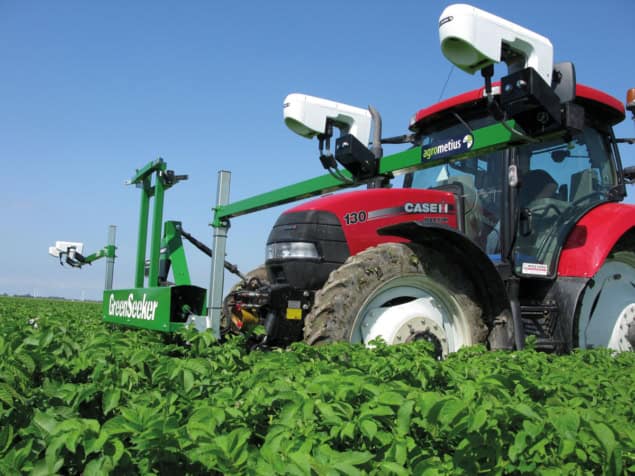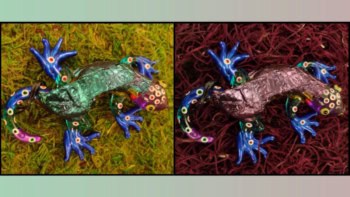Optical sensors that can inspect and treat crops are helping farmers optimize their harvests by adjusting how much fertilizer they apply, finds Martin Griffiths

During the Second World War, the US military developed a method to distinguish real plants from enemy camouflage based on the way they react to light. Chlorophyll absorbs blue and red light while reflecting green, giving plants their colour. But plant cells also reflect infrared light, which is not energetic enough for photosynthesis, to prevent overheating. Therefore, while green camouflage looks the same colour as a plant to the naked eye, it appears dark on an infrared film, while vegetation appears white.
As remote sensing from satellites became possible in the 1960s, this principle was developed into an index called the normalized difference vegetation index (NDVI), which relates reflectance in the visible region to the infrared. The NDVI also provides a measure of how healthy a plant is based on its photosynthetic activity: an increase in the reflectance of red light indicates that a plant is not photosynthesizing as effectively as usual, perhaps because of drought or lack of nutrients. However, satellite NDVI measurements are also affected by atmospheric conditions, satellite geometry and the angle of incidence of the Sun’s radiation.
Gauging a plant’s needs
To get round these complications, in the 1990s plant scientists and agricultural engineers at Oklahoma State University in the US developed ground-based optical sensors. Their aim was to use NDVI measurements to gauge a plant’s nitrogen needs, thereby allowing farmers to adjust the amount of fertilizer applied to a crop. Early sensors were passive and worked by measuring light reflected from the Sun, which varies during the course of a day and with the level of cloud cover. In 1998, however, researchers developed active sensors using LEDs as a red and infrared source, and by 2002 US firm NTech Industries had commercialized the technology under the trademark “GreenSeeker”.
Big business
Crop sensing has expanded rapidly in the last few years, with the acquisition of NTech by Californian firm Trimble in 2009 and the appearance of competitors such as Holland Scientific’s Crop Circle and Topcon’s CropSpec, which uses a laser diode rather than an LED source. In today’s systems, several sensors are mounted along a boom attached to a tractor and readings are used to adjust the levels of fertilizer being applied in real time. A typical four-sensor GreenSeeker system costs in the region of $10,000, but the resulting savings can be much bigger according to Trimble’s Anna Hebert. “A farmer in Oklahoma saved more than $32,000 in fertilizer costs in 2013 ($24 per acre) and more than $175,000 since he began using GreenSeeker in 2005,” she says.
The next move for agricultural optics appears to be upwards. Andreas Burkart at the Jülich Research Centre in Germany is leading a project to observe crops using a lightweight spectrometer made by US firm Ocean Optics aboard an unmanned aerial vehicle (UAV). “The dream of such an ‘eye in the sky’ is old,” says Burkart, “but now UAVs can be readily purchased and configured so that even a biologist like me can operate one easily.” The restricted payloads and flight times of UAVs make such systems more suitable for crop observation than treatment. Indeed, according to Michael Allen of Ocean Optics, the UAV device captures data about 20 times faster than with traditional ground-based techniques without causing any disturbance to the crops. “That’s a huge advantage when you have to assess dozens of acres of cropland,” Allen told Physics World.
The next step, says the Jülich team, is to use spectral data to reconstruct a full phenotype, including the size of plants, and the number and colour of their leaves. A UAV could then quickly scan an area containing several different varieties of a crop, such as barley, and assess how each performs in different conditions. Trimble launched its first UAV system targeted at farmers in January.
Unlike ground-based active optical sensors, measurements from the air rely on reflected light. But a recent project by a multidisciplinary group at the University of New England in Australia aims to get the best of both worlds by mounting off-the-shelf active optical sensors on ultra-low-level aircraft flying 3–5 m above the ground.
Detecting disease
Researchers are also developing more advanced sensors. For example, the small amount of red light re-emitted after being absorbed in photosynthesis, known as chlorophyll fluorescence, can provide a sensitive indicator of plant stress. Optical techniques have even been demonstrated that can detect plant diseases before they can be ascertained any other way, allowing the preventative application of pesticides. By studying the reflectance spectra of sugar-beet crops infected with three different fungal pathogens, a team from the Institute for Crop Science and Resource Conservation at the University of Bonn in Germany has recently identified spectral features that are correlated with each disease.
“From online measurements of the fat content of milk to screening incoming materials for food manufacturing, optical solutions are becoming mainstream,” says Allen. “Miniaturization and ease of use will drive more farmers to optical technologies.”



